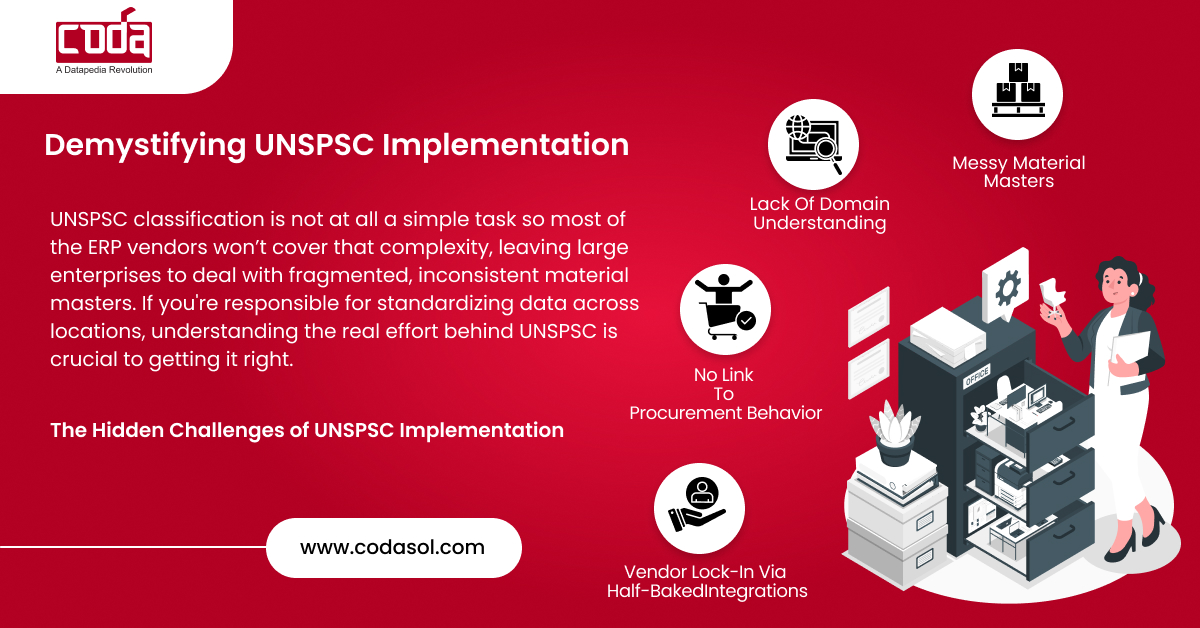Demystifying UNSPSC Implementation: What ERP Vendors Won’t Tell You
UNSPSC classification sounds simple. But implementing it across a multi-location, asset-heavy enterprise? That’s where most ERP vendors hit pause and leave you with the fallout. Why? Because addressing UNSPSC at scale means admitting their platform alone isn’t enough. UNSPSC implementation requires deep data cleansing, classification logic, and governance capabilities that they don’t want to be held accountable for.
If you’re an IT head, CPO, or data steward trying to standardize your materials master using UNSPSC, this is the clarity you’ve been looking for. This post unpacks everything you need to know about UNSPSC implementation in the context of large-scale industrial ERP environments.
Let’s break it down together.
What Is UNSPSC, Really?
UNSPSC (United Nations Standard Products and Services Code) is a global taxonomy used to classify both products and services. Think of it like a universal language for procurement. It helps organizations:
- Streamline purchasing
- Improve spend analytics
- Reduce duplicates
- Simplify supplier negotiations
Each UNSPSC code is made up of four levels:
| Level | Description | Example |
|---|---|---|
| Segment | Broad category | 43 – Information Technology |
| Family | Grouping by function | 4321 – Computer Equipment |
| Class | Type of product | 432115 – Laptops |
| Commodity | Specific item | 43211503 – Ultrabook Laptop |
In theory, it’s neat. In reality, mapping your legacy material data to this structure is a multi-headed monster.
Why ERP Vendors Don’t Talk About It
ERP systems (like SAP, Oracle, Maximo) offer UNSPSC as an optional field. But here’s the kicker—when the field is left empty or inconsistently populated, procurement teams lose visibility. For example, one global manufacturer discovered that 27% of their high-spend items were duplicated under different names, simply because they lacked a standard classification. This resulted in missed bulk purchase discounts, bloated inventories, and unnecessary supplier negotiations. What they don’t offer is:
- Clean, classified material data to begin with
- A centralized data governance layer
- Domain expertise in MRO materials
- Bulk classification tools that can handle real-world messiness
This means you’re left with a nice-looking field and a colossal task.
The Hidden Challenges of UNSPSC Implementation
1. Messy Material Masters
Most asset-intensive enterprises have hundreds of thousands of materials. Spares, consumables, one-time items, assets—it’s a jungle.
And most of it looks like this:
“BOLT M10X50 SS316” “Bolt SS 316 M10X50” “BOLT 10MM STAINLESS”
Which one gets which UNSPSC code? Without a clean, standardized format, automation tools are useless.
2. Lack of Domain Understanding
UNSPSC classification requires contextual understanding. A “pump” for crude oil operations and a “pump” for a hospital ICU may share the same word—but they don’t belong in the same class.
3. No Link to Procurement Behavior
If your procurement team doesn’t use the UNSPSC data, it stays as digital shelfware. Integrating the classification with procurement templates, catalogs, and vendor master is a must—but often skipped.
4. Vendor Lock-in via Half-Baked Integrations
Many ERP vendors offer limited automation tools for classification. You’ll end up:
- Hiring external consultants
- Manually mapping thousands of items
- Realizing that your ERP’s data model isn’t flexible enough
How to Do UNSPSC Right (Even If Your ERP Doesn’t Help)
Step 1: Cleanse and Normalize Your Data
Before classification, standardize descriptions using AI-based parsing tools or rules-based engines. For example:
“M10X50 BOLT SS316” → “BOLT, HEX HEAD, M10 X 50MM, STAINLESS STEEL 316”
Step 2: Use an External Classification Engine (AI-driven UNSPSC mapping tool)
Use an AI/ML-driven MDM tool (like PROSOL by CODASOL) to map materials to the right UNSPSC codes. These tools:
- Understand material semantics
- Cross-check historical buying behavior
- Offer confidence scores and human-in-the-loop validation
Step 3: Build Governance Around It
UNSPSC implementation isn’t a one-time job. Set up governance to:
- Approve new item creation
- Validate classification consistency
- Monitor data quality KPIs
Step 4: Close the Loop with Procurement
Make UNSPSC a requirement for RFQ templates, purchase requests, catalogs, and vendor onboarding. Don’t just classify for compliance, classify for cost savings.
Want to see how our MDM tool, Prosol maps UNSPSC codes with 98% accuracy?

Case study
A leading EPC firm in Saudi Arabia had over 120,000 material items. Their ERP had the UNSPSC field, but only 3% of entries were filled. Procurement was chaotic with frequent duplicates, poor analytics, and missed volume discounts.
CODASOL was brought in to lead the transformation. Using its AI-driven MDM platform and deep domain expertise in industrial material management, the firm:
- Classified over 95% of items within 3 months
- Reduced duplicate entries by 28%
- Uncovered $2.3M in potential procurement savings through improved analytics
This partnership not only brought clarity to their material master but also embedded sustainable governance for future scalability.
UNSPSC vs Other Classification Standards
| Standard | Purpose | Strengths | Weaknesses |
|---|---|---|---|
| UNSPSC | Global procurement | Universally recognized, ERP-ready | Broad codes, lacks domain nuance |
| eCl@ss | Technical & industry | Detailed, engineering-friendly | Less known in Asia & Middle East |
| NIGP | Government spend | Deep in public sector compliance | Not relevant to private industries |
Takeaway:
For most industrial enterprises across global markets, UNSPSC strikes the best balance between universal acceptance and ERP compatibility. However, pairing it with a domain-aware MDM platform ensures you avoid over-generalization and classification errors.

Stop struggling with ERP limitations. Discover how CODASOL’s MDM platform makes UNSPSC implementation effortless.
FAQs: UNSPSC Implementation in Industrial ERPs
1: Can I automate UNSPSC classification completely?
Partially. AI tools can handle 80–90% accuracy depending on data quality. Final validation by domain experts is still recommended.
2: Is UNSPSC mandatory for ERP usage?
No, but many companies adopt it for procurement standardization, especially in global operations.
3: What’s the ROI of implementing UNSPSC codes?
Clients have seen 20–30% reduction in maverick spending, 15% drop in duplicate materials, and major time savings in sourcing.
4: Does it affect vendor onboarding?
Yes. Standard codes help vendors match catalog items accurately, reducing errors in ordering and delivery.
5: Is UNSPSC relevant outside procurement?
Absolutely. It improves analytics, forecasting, compliance reporting, and even ESG tracking in some cases.
Final Word
UNSPSC implementation for industrial ERPs isn’t just a technical upgrade; it’s a foundational enabler for better procurement, compliance, and cost control. Don’t let your ERP vendor’s silence cost you millions.
Go beyond the checkbox. Implement UNSPSC with strategy, intelligence, and the right tools.

